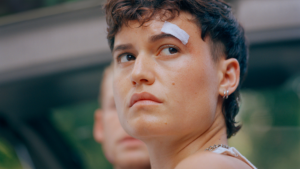Students at San Diego State University–Imperial Valley. Photo by Jennifer Prediger.
Nate von Zumwalt, Editorial Coordinator
Imperial Valley and Australia would appear to be in diametric contradiction to one another. One resides in the Northern Hemisphere, while the other sits well below the equator. One is home to a Spanish-speaking majority, and the other’s national language is English. And when one basks in the sun, the other rests under the stars. It’s night and day—quite literally.
But this glaring disparity has only facilitated the core mission of FILM FORWARD—to advance cultural dialogue—during this week’s program in Imperial Valley and Mexicali, where Aboriginal Australian director Rachel Perkins has screened her film Bran Nue Dae to local residents. With each screening and subsequent conversation comes the realization that despite these geographical, cultural, and sociological contrasts, a level of human understanding persists.
On Tuesday, Perkins screened Bran Nue Dae to a class of literature and writing composition students at the San Diego State University campus in Imperial Valley, which sits a mere six blocks north of the U.S./Mexico border. According to Bret Kofford, an English professor at the university, the student population is 90-percent Mexican-American, 70-percent of which are second-language learners. Living in such a remote locale, the students’ access to the arts is extremely limited and the FILM FORWARD screening and discussion provided a unique experience.
“These are the kinds of things they are just becoming aware of during their university years,” said Kofford. “To expose them to this kind of cultural event in a fairly isolated area is a big opportunity.”
Bran Nue Dae is adapted from a popular Australian stage musical and features a cast of mostly Aboriginal actors as it follows the young Willie after he ditches his Catholic boarding school to return to his homeland, Broome. And despite its light-hearted, often irreverent tone, the film does exhibit its fair share of racial undertones.
“The history of representation of Indigenous people in Australian cinema has been as social problems and as part of historical injustices,” said Perkins, responding to a student’s question about the film’s reception among Aborigines. “People were relieved that they could go in and have their Aboriginality celebrated.”
It was just one of many parallels that appeared to resonate with the young Mexican-American audience. Perkins is just one of a handful of Indigenous Australians to have released a feature film, and the only to have made a musical (two, in fact). She hinted at a similar dearth within the Mexican-American community, and solicited responses about the number of American filmmakers of Mexican descent.
Gregory Nava, Robert Rodriguez, Edward James Olmos…the numbers were bleak.
“So we’re sort of in the same boat in terms of how our culture is represented and where our people are in the industry,” noted Perkins.
It was a sobering fact. But with a director in the room who had transcended the invented boundaries established in her own culture, the realization among the students set in: culture, race, or locale are no match for the passion and drive of an artist.







